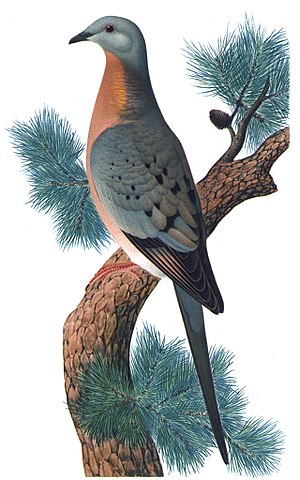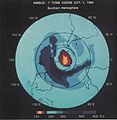Portal:Environment
Introduction The natural environment or natural world encompasses all living and non-living things occurring naturally, meaning in this case not artificial. The term is most often applied to Earth or some parts of Earth. This environment encompasses the interaction of all living species, climate, weather and natural resources that affect human survival and economic activity. The concept of the natural environment can be distinguished as components:
In contrast to the natural environment is the built environment. Built environments are where humans have fundamentally transformed landscapes such as urban settings and agricultural land conversion, the natural environment is greatly changed into a simplified human environment. Even acts which seem less extreme, such as building a mud hut or a photovoltaic system in the desert, the modified environment becomes an artificial one. Though many animals build things to provide a better environment for themselves, they are not human, hence beaver dams, and the works of mound-building termites, are thought of as natural. (Full article...)  The natural environment or natural world encompasses all living and non-living things occurring naturally, meaning in this case not artificial. The term is most often applied to Earth or some parts of Earth. This environment encompasses the interaction of all living species, climate, weather and natural resources that affect human survival and economic activity. The concept of the natural environment can be distinguished as components:
In contrast to the natural environment is the built environment. Built environments are where humans have fundamentally transformed landscapes such as urban settings and agricultural land conversion, the natural environment is greatly changed into a simplified human environment. Even acts which seem less extreme, such as building a mud hut or a photovoltaic system in the desert, the modified environment becomes an artificial one. Though many animals build things to provide a better environment for themselves, they are not human, hence beaver dams, and the works of mound-building termites, are thought of as natural. People cannot find absolutely natural environments on Earth, and naturalness usually varies in a continuum, from 100% natural in one extreme to 0% natural in the other. The massive environmental changes of humanity in the Anthropocene have fundamentally effected all natural environments: including from climate change, biodiversity loss and pollution from plastic and other chemicals in the air and water. More precisely, we can consider the different aspects or components of an environment, and see that their degree of naturalness is not uniform. If, for instance, in an agricultural field, the mineralogic composition and the structure of its soil are similar to those of an undisturbed forest soil, but the structure is quite different. (Full article...) Selected article -Earth Day is an annual event on April 22 to demonstrate support for environmental protection. First held on April 22, 1970, it now includes a wide range of events coordinated globally by EARTHDAY.ORG (formerly Earth Day Network) including 1 billion people in more than 193 countries. The official theme for 2024 is "Planet vs. Plastics." 2025 will be the 55th anniversary of Earth Day. In 1969 at a UNESCO Conference in San Francisco, peace activist John McConnell proposed a day to honor the Earth and the concept of peace, to first be observed on March 21, 1970, the first day of spring in the northern hemisphere. This day of nature's equipoise was later sanctioned in a proclamation written by McConnell and signed by Secretary General U Thant at the United Nations. A month later, United States Senator Gaylord Nelson proposed the idea to hold a nationwide environmental teach-in on April 22, 1970. He hired a young activist, Denis Hayes, to be the National Coordinator. Nelson and Hayes renamed the event "Earth Day". Denis and his staff grew the event beyond the original idea for a teach-in to include the entire United States. Key non-environmentally focused partners played major roles. Under the leadership of labor leader Walter Reuther, for example, the United Auto Workers (UAW) was the most instrumental outside financial and operational supporter of the first Earth Day. According to Hayes: "Without the UAW, the first Earth Day would have likely flopped!" Nelson was later awarded the Presidential Medal of Freedom award in recognition of his work. The first Earth Day was focused on the United States. In 1990, Denis Hayes, the original national coordinator in 1970, took it international and organized events in 141 nations. On Earth Day 2016, the landmark Paris Agreement was signed by the United States, the United Kingdom, China, and 120 other countries. This signing satisfied a key requirement for the entry into force of the historic draft climate protection treaty adopted by consensus of the 195 nations present at the 2015 United Nations Climate Change Conference in Paris. Numerous communities engaged in Earth Day Week actions, an entire week of activities focused on the environmental issues that the world faces. On Earth Day 2020, over 100 million people around the world observed the 50th anniversary in what is being referred to as the largest online mass mobilization in history. (Full article...)Did you know (auto-generated) -
Selected image - The passenger pigeon was a species of pigeon that was once the most common bird in North America. It is estimated that there were as many as five billion passenger pigeons in the United States at the time Europeans colonized North America. They lived in enormous flocks, and during migration, one could see flocks of them a mile (1.6 km) wide and 300 miles (500 km) long, taking several days to pass and probably containing two billion birds. The species had not been common in the Pre-Columbian period, until the devastation of the American Indian population by European diseases. Over the 19th century, the species went from being one of the most abundant birds in the world to extinction. At the time, passenger pigeons had one of the largest groups or flocks of any animal, second to only the desert locust. Some decimation in numbers occurred as a result of loss of habitat, when the Europeans started settling further inland. However, the primary factor emerged when pigeon meat was commercialized as a cheap food for slaves and the poor in the 19th century, resulting in hunting on a massive scale. There was a slow decline in their numbers between about 1800 and 1870, followed by a catastrophic decline between 1870 and 1890, at the end of which they were rare and beyond the point of recovery. 'Martha', thought to be the world's last passenger pigeon, died on September 1, 1914 in Cincinnati. Current events
Selected biography -Albert Arnold Gore Jr. (born March 31, 1948) is an American politician, businessman, and environmentalist who served as the 45th vice president of the United States from 1993 to 2001 under President Bill Clinton. He previously served as a United States Senator from Tennessee from 1985 to 1993 and as a member of the U.S. House of Representatives from 1977 to 1985. Gore was the Democratic nominee for president of the United States in the 2000 presidential election, which he lost to George W. Bush. The son of politician Albert Gore Sr., Gore was an elected official for 24 years. He was a U.S. representative from Tennessee (1977–1985) and from 1985 to 1993 served as a U.S. senator from that state. He served as vice president during the Clinton administration from 1993 to 2001, defeating incumbents George H. W. Bush and Dan Quayle in 1992, and Bob Dole and Jack Kemp in 1996. As of 2024, Gore's 1990 re-election remains the last time Democrats won a Senate election in Tennessee. (Full article...)Selected organization -
Agenda 21 is a non-binding action plan of the United Nations with regard to sustainable development. It is a product of the Earth Summit (UN Conference on Environment and Development) held in Rio de Janeiro, Brazil, in 1992. It is an action agenda for the UN, other multilateral organizations, and individual governments around the world that can be executed at local, national, and global levels. One major objective of the Agenda 21 initiative is that every local government should draw its own local Agenda 21. Its aim initially was to achieve global sustainable development by 2000, with the "21" in Agenda 21 referring to the original target of the 21st century. (Full article...)
General images -The following are images from various environment-related articles on Wikipedia.
Selected quote -More did you know -
Main topicsRelated articlesThings you can do
Related categoriesRelated portalsWikiProjectsAssociated WikimediaThe following Wikimedia Foundation sister projects provide more on this subject:
Discover Wikipedia using portals |

























































































